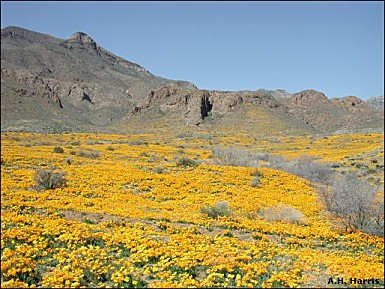
Too often, we focus on averages rather than other aspects of the world around us. For example, we average between 8 and 9 inches of annual precipitation. But this tells only part of the story. Native grasses depend on summer rainfall for reproduction and may set seed only in exceptionally wet summers. On the other hand, some of our most spectacular desert wildflower displays depend on winter precipitation.
The magnificent display of Mexican Poppies in the late winter and
spring of 2003 are a case in point. In years of normal winter precipitation, poppies
bloom only scantily. By the end of 2002, the northern Chihuahuan Desert was into
several years of hard drought, even by local standards. Yet, thanks to the distribution
of the sparse moisture, with much of it falling within the winter season, 2003 was a
banner year for the poppies. The lower slopes on the eastern side of the Franklin
Mountains blazed with a glory only rarely seen. As we humans face severe cutbacks in
water use, the poppies glory in their year of plenty.
![]()
Contributor: Arthur H. Harris, Laboratory for Environmental Biology, Centennial Museum, University of Texas at El Paso.
Desert Diary is a joint production of the Centennial Museum and KTEP National Public Radio at the University of Texas at El Paso.

Mexican Poppies in the spring of 2003, Franklin Mountains in the background. Photograph by A.H. Harris.
Virtual Exhibit, Centennial Museum.